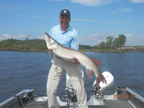
Posts: 3508
Location: Elk River, Minnesota | bigmckee,
I'd be looking for a second opinion from someone else then.... A good transom saver is going to be one that is either A) built out of steel, or B) has thicker square aluminum tubing which increases the strength. The additional load the guy is talking about is a horizontal load when you consider the force acting directly on the trailer, which, due to the design of trailers today would have absolutely no possible way of causing any major amount of stress to the trailer.
The whole idea of the transom saver is to stop the bouncing and keep the boat and trailer frame moving as one unit rather than independently of each other. The independent movement is what causes stress and the potential for damage.
If the motor is tightened down on the saver properly, that motor, although it may move left to right, will not have any sort of rotational movement (bouncing along the curve of trimming) happening whatsoever. The trailer takes the main brunt of any shock via the springs. The saver takes any sort of rotational movement of the motor where it is attached to the transom away as there is no movement that can happen due to the support of the saver.
In many ways, the transom saver and it's premise is similar to the same support system that is used in shelving, older deer stands, trusses, etc. All are designed to support outer edges of things away from a vertical surface by allowing the vertical force to be transferred back at a different angle, which significantly lessens the vertical force being applied to the support structure itself. and all do very well, otherwise they wouldn't be using the system yet...especially in trusses on bridge construction where there are constant forces up and down... Triangles are everywhere...
Steve
Edited by VMS 3/7/2014 11:28 PM
|





